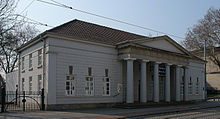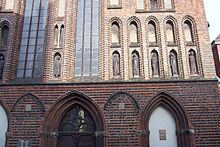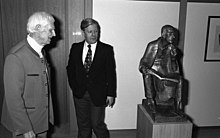Gerhard Marcks
Gerhard Wilhelm Albert Marcks (born February 18, 1889 in Berlin ; † November 13, 1981 in Burgbrohl ) was a German sculptor and graphic artist . From 1919 to 1924 he worked as a teacher at the State Bauhaus in Weimar and from 1925 as head of the sculpture class at the Burg Giebichenstein Art School in Halle , where he took over the rectorate in 1928. In 1933 he was dismissed by the National Socialists, who then defamed several of his works in the exhibition “ Degenerate Art ”.
In 1945 he was offered a call to the State Art School in Hamburg, and from 1950 he worked as a freelancer. In 1971 the Gerhard-Marcks-Haus was opened in Bremen , which manages his artistic estate.
biography
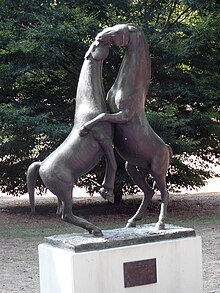
Marcks was a self-taught sculptor from the Berlin Secession environment . The French sculptor Auguste Rodin was an important inspiration for his anti-academic stance .

From 1908 Marcks worked in a workshop community with the sculptor Richard Scheibe . In the first few years he enjoyed the guidance of August Gaul and Georg Kolbe . He also dealt with porcelain; In the Schwarzburg workshops for porcelain art Unterweißbach, which were under the direction of Max Adolf Pfeiffer , he created several animal sculptures.
1912–1913 he was a one-year volunteer for military training with the infantry regiment "Lübeck" (3rd Hanseatic) No. 162 in Lübeck. Then he received an order for the Cologne Werkbund exhibition in conjunction with Walter Gropius .
In 1914 he married Maria Schmidtlein. He was up for military service in World War I moved in. Because he became seriously ill, he was released from military service in 1916.
In 1917 he worked with the Velten-Vordamm stoneware factory . Colored, glazed animal sculptures were created that were intended for series production. From 1918 he taught at the Staatliche Kunstgewerbeschule in Berlin with Bruno Paul . In 1919 he was appointed to the State Bauhaus in Weimar . From 1920 he headed the Bauhaus pottery in Dornburg / Saale ; he worked there with Otto Lindig , Max Krehan , Marguerite Friedlaender and Franz Rudolf Wildenhain . Because of his friendship with Lyonel Feininger , he was encouraged to work with woodcuts .
For the Bauhaus exhibition in 1923 he suggested a "handy abbreviation": "Bau Hau auwei! (Namely Bauhaus exhibition Weimar)". He wrote to Walter Gropius on October 9, 1925: "... that we belong to two different worlds. But, as far as this framework allowed, you have never denied me your friendship, and I thank you for that! Contempt, I want to keep it that way too. " - The Bauhaus pottery was not taken over when moving to Dessau.
On September 15, 1925, he was appointed to teach the sculpture class at the Burg Giebichenstein Art School in Halle . He went on study trips to Paris together with Charles Crodel , Italy ( Villa Massimo ) and Greece . In 1928 he received the Villa Romana Prize. After Paul Thiersch was appointed to the Technical University of Hanover , he took over the acting directorate at Burg Giebichenstein in 1928 until his resignation (acting as a deputy because he did not want to become a civil servant).
In 1933 he was dismissed because he had campaigned for Jewish teachers such as Marguerite Friedländer-Wildenhain to remain at the art school. He moved to Niehagen , now part of Ahrenshoop in Mecklenburg . In 1935 he was a student at the Villa Massimo in Rome for five months, and from 1936 he worked in Berlin. The music room of the Burse zur Tulpe (student house of the University of Halle / Saale), which was carried out jointly with Crodel, was destroyed in 1936, and Marcks then moved into studio room no . In 1937 the National Socialists confiscated 86 of his works and defamed several of his works in the exhibition “ Degenerate Art ”. He was warned against a house search by his former master student Wilhelm Löber , who was then expelled from the SA in 1938 .
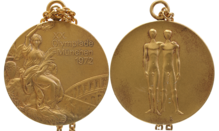
In 1945 he was appointed to the State Art School in Hamburg, from 1950 he worked freelance in Cologne , where the city provided him with a house in Müngersdorf built by Wilhelm Riphahn . He had been a member of the Berlin Academy of the Arts since 1955 . In 1980 he was elected as an honorary foreign member of the American Academy of Arts and Letters .
For the 1972 Summer Olympics in Munich, Gerhard Marcks was allowed to design the back of the winners' medals. He chose the ancient half-brothers Castor and Polydeukes , who were considered patron saints of fighting games and friendship among the Greeks , as the illustration .
In the early 1970s he withdrew to the Eifel, where he had bought a country house. He died there on November 13, 1981. Before that he produced one last life-size work, which is considered a legacy, the bronze "Prometheus and the Zeus Eagle".
His large circle of friends also included u. a. Waldemar Grzimek , Ernst Barlach , Oskar Schlemmer , Lyonel Feininger , Charles Crodel, Ludwig Kaspar and Wilhelm Nauhaus . Christian Höpfner (since 1976) and Friedrich B. Henkel were among his younger friends .
The cartoonist Marie Marcks is his niece.
The grave of Gerhard Marcks and his family is located on a hill near the northern pond at the Ohlsdorf cemetery in Hamburg .
Exhibitions and honors
In 1914 he was in exhibitions of the Berlin Secession and German Work Federation involved, after the Second World War at the Biennale in Venice and at the documenta I (1955), the documenta II (1959) and the documenta III (1964) in Kassel .
1939 Robert Pudlich : pictures, watercolors and drawings; Gerhard Marcks, Zoltan Székessy : Sculptures and drawings: 36th exhibition (with Karl Buchholz in Berlin)
In 1949 he received the Goethe plaque from the city of Frankfurt am Main .
In 1951 he was elected to the first board of the re-established German Artists Association.
In 1952 he was appointed knight of the peace class of the order Pour le Mérite .
In 1954 he received the Great Art Prize of the State of North Rhine-Westphalia and in 1955 the Art Prize of the City of Berlin.
In 1962 he became an honorary member of the Academy of Fine Arts in Nuremberg .
In 1967 the Senate of the Free and Hanseatic City of Hamburg awarded him the Medal for Art and Science .
In 1979 he was honored on his 90th birthday by exhibitions in Berlin, Bremen, Cologne and Nuremberg, as well as by being awarded the Great Cross of Merit with a star and shoulder ribbon of the Order of Merit of the Federal Republic. In 1980 he became an honorary member of the Academy of Letters in New York, together with Max Ernst and Karlheinz Stockhausen .
In 1990 the Roswitha Haftmann Modern Art gallery in Zurich showed sculptures, drawings and woodcuts.
The minor planet ( asteroid ) (10778) Marcks (1991 GN10) was discovered on April 9, 1991 and named in his honor.
In cooperation with the Gerhard-Marcks-Haus in Bremen, the Klassik Stiftung Weimar presented the exhibition “Ways out of the Bauhaus. Gerhard Marcks and his Circle of Friends ”in the Neues Museum Weimar. The exhibition was on view in the Gerhard-Marcks-Haus from November 26, 2017 to March 4, 2018. It was the opening exhibition of the Klassik Stiftung for the 100th anniversary of the Bauhaus in 2019.
From June 10 to December 16, 2018, sacred sculptures were exhibited in the collegiate church of the Cappenberg monastery .
In the art gallery “Talstrasse” in Halle (Saale) from November 18, 2018 to February 24, 2019, the exhibition “We go to Halle” on Marguerite Friedlaender and Gerhard Marcks was shown, a contribution to the Bauhaus anniversary in 2019. Then the exhibition from March 7, 2019 to June 30, 2019 in the Gerhard-Marcks-Haus Bremen.
estate
The written estate is in the German Art Archive in the Germanic National Museum in Nuremberg . The Gerhard-Marcks-Haus in Bremen manages his artistic estate and shows it in various exhibitions. The museum opened in September 1971.
Works in galleries and museums (selection)
- Gerhard Marcks House, Bremen
- Art collections of the Veste Coburg , Coburg
- State Gallery Moritzburg, Halle
- Schleswig-Holstein State Museum, Schleswig
- Bielefeld art gallery
- Lower Saxony State Gallery, Hanover
- Kunsthalle Hamburg
- Museum of Fine Arts, Boston / USA
- Hirshhorn Museum, Washington
- Vatican Museum, Rome
- Wallraf-Richartz-Museum, Cologne
- State Gallery Stuttgart
- South African National Gallery, Cape Town
- Folkwang Museum, Essen
- State Lindenau Museum, Altenburg
- Kunsthalle Mannheim
- Karl Ernst Osthaus Museum, Hagen
- Baltimore Museum of Art / USA
- Rostock art gallery
- New National Gallery Berlin (SMPK)
- Museum of Modern Art New York / USA
- Art collections Dresden
- Angermuseum Erfurt
- Museum of Fine Arts Leipzig
- Behnhaus Lübeck
- Die Neue Sammlung - State Museum for Applied Arts / The Design Museum, Munich
Sculptures in public space (selection)
- Horse and Cattle on the Piers of the Kröllwitzer Bridge in Halle (1928)
- Thuringian Venus (1930) in the museum park in Braunschweig
- Community of saints on the west facade of the Lübeck Katharinenkirche , museum church of the Museum for Art and Cultural History of the Hanseatic City of Lübeck
- Der Rufer on Berliner Strasse des 17. Juni with the Peace Sonnet by Francesco Petrarca
- The Rufer , who had stood on the former Radio Bremen television siteon Hans-Bredow-Strasse for 40 years, was re-unveiled there on November 23, 2007 after being moved to the inner-city bank of the Weser. Here it stands on a rotating base and looks over the Weser - for live broadcasts like 3 to 9 it is rotated 180 degrees and looks towards the studio
- The Mourners (1949) in the Lichhof in front of St. Maria in the Capitol in Cologne
- Charons Nachen (1951), also known as the ride across the Styx , integrated into the memorial for the bomb victims (inaugurated in 1952) at the Ohlsdorf (park) cemetery in Hamburg
- Angel of Peace , popularly known in Mannheim as Die Schepp 'Liesel , (inaugurated November 16, 1952 in B4), today's location in E6 in Mannheim
- Empedocles , since 2013 in the entrance building of the IG Farben building on the Westend campus . Previously since November 11, 1954 in the entrance hall of the main building of the Frankfurt Goethe University on the Bockenheim campus
- Mourners (1955) Memorial to the victims of the Second World War, Bochum
- St. Sebastian (1956) memorial for the dead of both World Wars and for the victims of National Socialism , Bergheim
- Bronze portal of the Marktkirche in Hanover (1959)
- Prophet and Genius (1961) in the (park) cemetery Ohlsdorf in Hamburg
- The mother . Marble sculpture in the ten meter high round building with twelve meters diameter of the German war cemetery in Bourdon in France
- Playing stallions (1962), in Warmen Damm, Wiesbaden
- Mozart monument in Frankfurt am Main (1963)
- Düxer Bock (1963), a fountain in Cologne-Deutz
- Der Gefesselte (1963/64), sculpture made of basalt, forecourt at Kunsthalle Osnabrück
- Gaea (1965) in the rose garden of the Rheinpark (a variation of Gaea II, half-covered (from the mold still modified by Marcks, 2005), is in the Stollwerkpassage on Hohe Straße ) both in Cologne
- Albertus Magnus (1956) bronze sculpture on Albertus-Magnus-Platz in front of the main entrance of the University of Cologne . In 1965 a second cast was made for the University of Bogota, a third cast in 1970 for the University of Texas in Houston, Texas, and finally at the instigation of daughter Brigitte Marcks-Geck - all from the workshop of the Schmäke art foundry , Düsseldorf - a cast for the 1996 University of Jena , as Marcks had close ties to Thuringia for many years. A smaller, more naturalistic variant of Albertus Magnus washanded over tothe Federal Chancellery in Bonn by Marcks in 1977to the then Chancellor Helmut Schmidt .
- Orpheus (1959), in the Heinz Hilpert Theater , Lünen ; a cast of the original statue was set upin Düren in 1980, and another cast has been in the main building of Justus Liebig University in Gießen since 1972.
- War and peace on the fairground in Bleicherode
- Equestrian statue of Saint George in front of the Dreieinigkeitskirche in Hamburg-St. George
- Freya in the museum garden of the Sparkasse, Duisburg
- Job (1957) on the square in front of the Klarakirche in Nuremberg
- Neighing stallion , Giessener Kunstweg
- Memorial for the victims of both world wars (1968) in the old town cemetery in Mülheim an der Ruhr
- The Guardian , bronze sculpture in front of the Oldenburg State Theater
- Bremen Town Musicians , bronze sculpture next to the Bremen Town Hall
- Sculpture garden of the citizenship in Bremen next to the citizenship house
- Sea eagle in bronze (1983) in Bremerhaven at the old Geestebrücke
- Fortuna in front of the Dortmund branch of the Deutsche Bundesbank
gallery
Freya (1950)
Great Adam in Grugapark , Essen (1953)
The Bremen Town Musicians (1953)
Albertus Magnus (1956)
The Shackled (1963/1964)
Gaea II (1965)
Aegina , Bremen, 1966
The Caller (1967)
Citizenship Sculpture Garden (1960–1969)
literature
- Adolf Rieth: Gerhard Marcks. Aurel Bongers, Recklinghausen 1959.
- Gerhard Marcks: Exhibition catalog plastic drawings graphics. Kunstverein Hannover , 1960.
- Martina Rudloff: Gerhard Marcks: The plastic work . Propylaea Publishing House. Frankfurt am Main u. a. 1977, ISBN 3-549-06620-1 .
- Volker G. Probst: Gerhard Marcks - thoughts on the work . Festschrift for the 90th birthday, Marco, Bonn-Paris 1979.
- Wilhelm Nauhaus : The Giebichenstein Castle. History of a German art school 1915–1933. Seemann, Leipzig 1981. (New edition Leipzig 1992, ISBN 3-363-00539-3 .)
- Martina Rudloff - Eduard Hindelang, Hans Purrmann - Gerhard Marcks. An artist friendship in letters. Museum Langenargen on Lake Constance - Gerhard-Marcks Foundation Bremen 1986. Published on the occasion of the tenth anniversary of the Museum Langenargen. Annual gift 1986 for the Friends of the Gerhard Marcks-Haus e. V.
- Martina Rudloff: Marcks, Gerhard. In: New German Biography (NDB). Volume 16, Duncker & Humblot, Berlin 1990, ISBN 3-428-00197-4 , pp. 125-127 ( digitized version ).
- Martina Rudloff (eds.): Gerhard Marcks and Charles Crodel . An artist friendship. Gerhard Marcks Foundation, Bremen 1992, ISBN 3-924412-16-2 .
- Burg Giebichenstein: The Halle Art School from the beginning to the present. Exhibition catalog Staatliche Galerie Moritzburg Halle / Badisches Landesmuseum, Karlsruhe 1993.
- Jens Semrau (Hrsg.): Through dark Germany - Gerhard Marcks correspondence 1933 to 1980. Seemann, Leipzig 1995, ISBN 3-363-00645-4 .
- Claus Pese: More than just art. The archive for fine arts in the Germanisches Nationalmuseum . Hatje, Ostfildern-Ruit 1998 ( Cultural and Historical Walks in the Germanisches Nationalmuseum , Volume 2), pp. 85–86, 115–119.
- Gerhard Marcks: Between Bauhaus and Dornburg Atelier. City Museums Jena (Ed.), Jena 2004, ISBN 3-930128-65-9 .
- The sculptor thinks !. Drawings by Gerhard Marcks. Bremen 2017, ISBN 978-3-924412-86-9 .
- Anke Blümm et al. (Ed.): Ways out of the Bauhaus. Gerhard Marcks and his friends. Weimar 2017. Catalog of the opening exhibition in Weimar and Bremen for the 100th anniversary of the Bauhaus in 2019.
- Anne Feuchter-Schawelka: Gerhard Marcks. Master of ceramics . Weimar publishing company in the publishing house Römerweg GmbH, Weimar 2017, ISBN 978-3-7374-0228-6 .
- Matthias Rataiczyk (Ed.): “We're going to Halle.” Marguerite Friedlaender Gerhard Marcks. Catalog book for the exhibition. Art association "Talstraße", Halle (Saale) 2018, ISBN 978-3-932962-96-7 .
- Renate Luckner-Bien: Marcks can laugh. The sculptor Gerhard Marcks in Halle an der Saale, Halle (Saale) 2019, ISBN 978-3-945377-56-7
Web links
- Gerhard Marcks House in Bremen
- Literature by and about Gerhard Marcks in the catalog of the German National Library
- Works by and about Gerhard Marcks in the German Digital Library
- Portrait at Kulturtussi.de
- In the footsteps of Gerhard Marcks
- Materials by and about Gerhard Marcks in the documenta archive
- Video: Gerhard Marcks in his studio, Cologne 1957 . Institute for Scientific Film (IWF) 1975, made available by the Technical Information Library (TIB), doi : 10.3203 / IWF / G-26 .
Individual evidence
- ^ Volker Wahl , Das Weimarer Bauhaus: a study book on its history 1919-1926. Jena: Vopelius 2019. p. 279.
- ^ Back cover of the catalog by Anke Blümm et al. (Ed.): Ways out of the Bauhaus. Gerhard Marcks and his friends. Weimar 2017.
- ↑ Rudolf Pillep, Giebichenstein Castle. Documents from 1915 to 1933, Halle 1990, Document 21.
- ↑ Crodel furnished the house with a colored glass window; see. Brigitte Klesse, Two glass windows by Charles Crodel for Ferdinand Möller. In: Kölner Museums-Bulletin 1997, No. 3, pp. 21–34.
- ^ Jobst C. Knigge: The Villa Massimo in Rome 1933–1943. Struggle for artistic independence, Humboldt University Berlin 2013 open access, p. 93ff.
- ↑ s. Short biography of Marcks, Gerhard. In: Ateliergemeinschaft Klosterstrasse - Berlin 1933–1945. Artist in the time of National Socialism. Academy of Arts (Edition Hentrich), Berlin 1994, ISBN 3-89468-134-9 .
- ↑ Renate Luckner-Bien: "I saw us all in the degenerate exhibition." In: M. Ratayczyk (Ed.): "We're going to Halle." Marguerite Friedlaender & Gerhard Marcks. Exhibition catalog. Halle (Saale) 2018, ISBN 978-3-932962-96-7 , p. 142.
- ^ Ernst Klee : The culture lexicon for the Third Reich. Who was what before and after 1945. S. Fischer, Frankfurt am Main 2007, ISBN 978-3-10-039326-5 , p. 392.
- ↑ Hartmut Gill: Wilhelm Löber - From the Bauhaus to Fischland and Rügen ceramics. Hinstorff Verlag, Rostock 2015.
- ^ Eduard Prüssen (linocuts), Werner Schäfke and Günter Henne (texts): Cologne heads . 1st edition. University and City Library, Cologne 2010, ISBN 978-3-931596-53-8 , pp. 112 .
- ^ Honorary Members: Gerhard Marcks. American Academy of Arts and Letters, accessed March 15, 2019 .
- ↑ Location of the Marcks family grave
- ↑ kuenstlerbund.de: Board members of the German Association of Artists since 1951 ( Memento from December 17, 2015 in the Internet Archive ) (accessed on November 11, 2015)
- ↑ Ludmila Vachtova. Roswitha Haftmann . P. 105
- ↑ 10778 Marcks (1991 GN10) , nasa.gov, accessed February 27, 2012.
- ↑ Website of the Klassik Stiftung Weimar ( Memento of the original from November 17, 2017 in the Internet Archive ) Info: The archive link was inserted automatically and has not yet been checked. Please check the original and archive link according to the instructions and then remove this notice. , accessed July 14, 2017.
- ↑ The caller . In: District lexicon of the Luisenstädtischer Bildungsverein
- ↑ Sabine Gertrud Cremer: The St. Sebastian by Gerhard Marcks - A memorial of the city of Bergheim . In: Yearbook of the Bergheim History Association . tape 5 , 1996, pp. 204-225 . ; Sabine Gertrud Cremer: The memorial of the city of Bergheim by Gerhard Marcks from 1957. 2017 (digitized)
- ^ City of Osnabrück, Art in Public Space
- ↑ for the Cologne works from portrait: Gerhard Marcks on kulturtussi.de (accessed July 1, 2008)
| personal data | |
|---|---|
| SURNAME | Marcks, Gerhard |
| ALTERNATIVE NAMES | Marcks, Gerhard Wilhelm Albert (full name) |
| BRIEF DESCRIPTION | German sculptor and graphic artist |
| DATE OF BIRTH | February 18, 1889 |
| PLACE OF BIRTH | Berlin |
| DATE OF DEATH | November 13, 1981 |
| Place of death | Burgbrohl (Eifel) |



